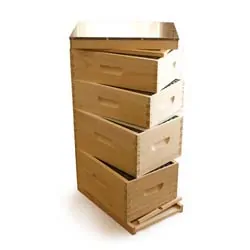Though an individual worker bee’s lifespan may only be a few weeks, or months in the case of winter bees, the colony knows their generational survival requires ample stored food resources. Honey offers bees a crucial form of carbohydrates and many nutrients, and quite a lot of it is needed to sustain a colony throughout a season.
Worker bees out foraging collect nectar from flowers using their proboscis, storing it in their honey stomachs until they return to their beehive. They’ll then transfer it to house bees, who add enzymes to break down sugars and fan their wings to reduce moisture. This process transforms the nectar into honey which has 18% water content or less, making it antibacterial and stable for storage during seasons where resources are scarce, like winter and early spring.
Because not all nectar (or pollen) sources bloom all year long, especially when weather is bad, bees whose hives are located close to a wide variety of plants are more likely to thrive since access to food sources isn’t as limited. If your colony doesn’t have many options close by, consider adding some yourself, and be prepared to offer supplemental food during times of dearth. (Check out the “Read More” section below for more on plants for bees and nectar dearths.)
Beekeepers just getting started should be wary about harvesting honey too soon or you could put bees at risk for starvation. If you’re confident that a 2nd year colony can spare some of their prized bounty, though, there are many options available to help you harvest, extract, bottle, and store honey. After removing honey supers, spilled honey in or around the bee yard should be cleaned up ASAP to avoid the smell attracting pests like bears. Even jarred and filtered honey can crystallize over time, especially when stored in a cold area, but it can be liquefied with gentle heat.
Read More
The Chemical Composition of Honey
A Closer Look at How Bees Make Honey
Tips & Tricks For Providing Pollinator Friendly Plants
Helping Bees Through a Nectar or Pollen Dearth
Intro to Harvesting Honey (Part 1)
Understanding the Honey Flow *
Intro to Honey Harvesting (Part 2) *
* Colony Member-Only Content
Related Products in the PerfectBee Store
Understanding Bee Anatomy (Book)
Our Honey Farm with Crayons (Coloring Book)
Major Flowers in the Northeast (Book)
